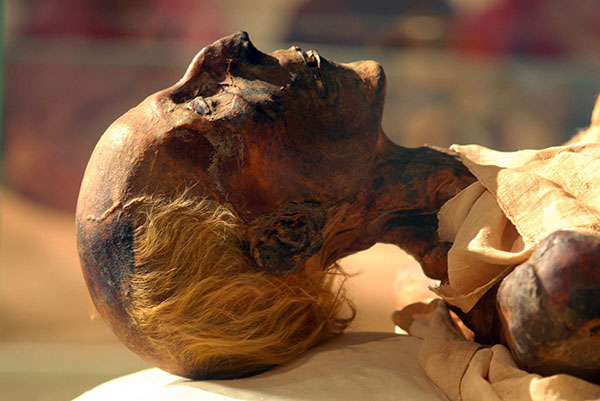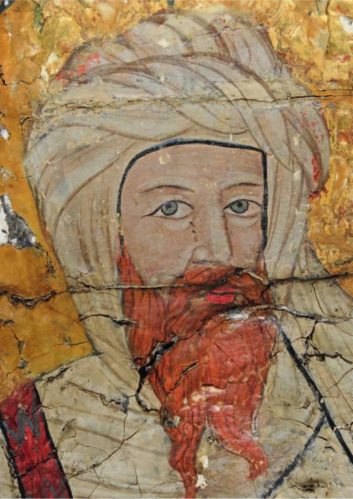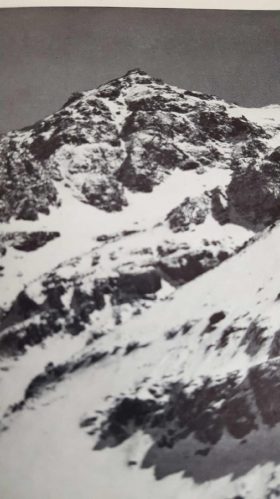Pharaoh Ramesses II
The analysis of the Pharaoh Ramesses II
The mummy was examined in 1886 by Gaston Maspero and Dr. Fouquet, first thorough investigation of the mummy. The investigations were carried out with the means of the time: detailed observation of the body, various measurements.
In 1974, to determine the causes of death of Ramesses II and other mummies, including that of Merneptah, investigations were undertaken under the direction of Maurice Bucaille with Egyptian colleagues and a dozen other French collaborators in various medical disciplines. The results were communicated among others, the Academy of Medicine and the French Society of Legal Medicine. His book The Mummies of the Pharaohs and medicine presents the final results of his research.
Many modern techniques were used, radiological and endoscopic explorations, investigations in the dental field, microscopic research, forensic, etc. A find of great importance due to the use of X-ray films of high sensitivity allowed to show the existence of a very serious injury to the jaw of Ramses II, extensive osteomyelitis of the lower jaw of dental origin. Maurice Bucaille concludes that these injuries were probably fatal condition that the king did not have other undetected serious diseases (due to the inability to examine the chest organs associated with mummification) and that could be the pharaoh who pursued Moses and the Hebrews, for he died in frightful suffering resulting total physical disability.
A study of the mummy of Ramesses II, the Museum of Man in Paris in 1976, concluded that the pharaoh was a “leucoderma, Mediterranean type similar to that of North African Amazigh”.
Pharaoh Ramesses II (of the 19th Dynasty), is generally considered to be the most powerful and influential King that ever reigned in Egypt. He is one of the few rulers who has earned the epithet “the Great”. Subsequently, his racial origins are of extreme interest.
In 1975, the Egyptian government allowed the French to take Ramesses’ mummy to Paris for conservation work. Numerous other tests were performed, to determine Ramesses’ precise racial affinities, largely because the Senegalese scholar Cheikh Anta Diop, was claiming at the time that Ramesses was black. Once the work had been completed, the mummy was returned in a hermetically sealed casket, and it has remained largely hidden from public view ever since, concealed in the bowels of the Cairo Museum. The results of the study were published in a lavishly illustrated work, which was edited by L. Balout, C. Roubet and C. Desroches-Noblecourt, and was titled La Momie de Ramsès II: Contribution Scientifique à l’Égyptologie (1985).
Professor P. F. Ceccaldi, with a research team behind him, studied some hairs which were removed from the mummy’s scalp. Ramesses II was 90 years-old when he died, and his hair had turned white. Ceccaldi determined that the reddish-yellow colour of the mummy’s hair had been brought about by its being dyed with a dilute henna solution; it proved to be an example of the cosmetic attentions of the embalmers. However, traces of the hair’s original colour (in youth), remain in the roots, even into advanced old age. Microscopic examinations proved that the hair roots contained traces of natural red pigments, and that therefore, during his youth, Ramesses II had been red-haired. It was concluded that these red pigments did not result from the hair somehow fading, or otherwise altering post-mortem,but did indeed represent Ramesses’ natural hair colour. Ceccaldi also studied a cross-section of the hairs, and he determined from their oval shape, that Ramesses had been “cymotrich” (wavy-haired). Finally, he stated that such a combination of features showed that Ramesses had been a “leucoderm” (white-skinned person). [Balout, et al. (1985) 254-257.]
Balout and Roubet were under no illusions as to the significance of this discovery, and they concluded as follows:
“After having achieved this immense work, an important scientific conclusion remains to be drawn: the anthropological study and the microscopic analysis of hair, carried out by four laboratories: Judiciary Medecine (Professor Ceccaldi), Société L’Oréal, Atomic Energy Commission, and Institut Textile de France showed that Ramses II was a ‘leucoderm’, that is a fair-skinned man, near to the Prehistoric and Antiquity Mediterraneans, or briefly, of the Berber of Africa.” [Balout, et al. (1985) 383.]
It is interesting to note the link to the North African Berbers: some Berber tribes, such as the Riffians of the Atlas Mountains, have incidences of blondism reaching almost 60%, and they have a percentage of red-haired people which is comparable to that of the Irish. [Coon & Hunt (1966) 116-117.]
These facts have not only anthropological interest however, but also great symbolic importance. In ancient Egypt, the god Seth was said to have been red-haired, and redheads were claimed to have worshipped the god devoutly. [Wainwright (1938) 31, 33, 53.] In the Ramesses study cited above, the Egyptologist Desroches-Noblecourt wrote an essay, in which she discussed the importance of Ramesses’ rufous condition. She noted that the Ramessides (the family of Ramesses II), were devoted to Seth, with several bearing the name Seti, which means “beloved of Seth”. She concluded that the Ramessides believed themselves to be divine descendants of Seth, with their red hair as proof of their lineage; they may even have used this peculiar physical feature to propel themselves out of obscurity, and onto the throne of the Pharaohs. Desroches-Noblecourt also speculated that Ramesses II may well have been descended from a long line of redheads. [Balout, et al. (1985) 388-391.]
Her speculations have been proved correct: Dr. Joann Fletcher, a consultant to the British Bioanthropology Foundation, has proved that Seti I (the father of Ramesses II), had red hair. [Parks (2000).] It has also been demonstrated that the mummy of Pharaoh Siptah (a great-grandson of Ramesses II), has red hair. [Partridge (1994) 169.]
We may also note the anthropological description of Ramesses’ mummy, which was written by the Biblical historian Archibald Sayce:
“The Nineteenth Dynasty to which Ramses II, the oppressor of the Israelites, belonged, is distinguished by its marked dolichocephalism of long-headedness. His mummy shows an index of 74, while the face is an oval with an index of 103. The nose is prominent, but leptorrhine and aquiline, and the jaws are orthognathous. The chin is broad, the neck long, like the fingers and nails. The great king seems to have had red hair.” [Sayce (1925) 136.]
All of these features are characteristics of the Nordic race. [Günther (1927) 10-23.] Finally, we should note that Professor Raymond Dart declared that the Nordic race was the “Egyptian Pharaonic type”. He then went on to state specifically, that the head of Ramesses II is “pelasgic ellipsoidal or Nordic” in type. [Dart (1939).]




By Helen Hagan
Dr. Hawass traveled to the
Oasis of Barhaya, located 200
kilometers west of Alexandria,
and visited Siwa, the Amazigh
(Berber) oasis south of Barhaya.
During the narration of his
journey to the two oases, Dr.
Zahi Hawass did not once mention
the ethnic population of this
desert area, be it now or at the
time the burials occurred (200
BC to 100 AD). When he
mentioned the small local temple
dedicated to Alexander the
Great near the Oasis of Barhaya,
he did state that Alexander
briefly voyaged from Alexandria
to the region. Surprisingly, Dr.
Hawass omitted to provide the
reasons and the extent of
Alexander’s journey. However,
the historical record is clear:
Alexander the Great only traversed
the region of Barhaya on
his way to the oasis of Siwa,
because he needed to reach the
source of legitimacy in Egypt,
where the first priesthood of the
central God of Egypt, Amon, is
said to have originated. He
needed to be empowered by the
Issiwann, spiritual guardians to
early Egyptian religious traditions.
The Greeks called the
inhabitants of the Oasis of Siwa
“Ammonioi”, and the locality
“Ammon.” The God Ammon
was the equivalent to Zeus in
Greek mythology or Jupiter in
the Roman pantheon of Gods.
Dr. Hawass not only omitted
these details, but he spoke
of traveling himself to the Oasis
of Siwa without indicating the
reason for his interest in it. Siwa
people are an Amazigh (Berber)
speaking group. In fact, the
whole region of this desert of
Western Egypt is known to
scholars for being Libyco-
Berber territory.
The field of mummies found
by Dr. Hawass is located near
the ruins of a fort dating back to
Roman occupation, which occurred
after the defeat of
Cleopatra and followed the
Greek colonization of the area.
The Greek Ptolemaic Dynasty
which was inaugurated by
Alexander the Great reigned in
Egypt from 600 BC to 200 BC
at Alexandria, and the Roman
colonization in the vicinity of
Alexandria lasted from that time
to about 100 AD. The dating
of this giant cemetery, tentatively
thought to cover four
square miles of desert, and
possibly holding the remains of
bodies, seem to span several
centuries over the Greco-
Roman period.
The slide pictures were impressive.
Some showed the gold
masks of the deceased that had
been sculpted from their actual
features. However, slide after
slide, it became apparent that
these deceased people were all
light-skinned, full-lipped,
straight-nosed, neither Nubians
nor Sudanese, not copperskinned,
not Asiatic, but indeed
Libyans, that is to say, Amazigh.
The Greeks and Romans who
colonized them collectively
called the Amazigh “Barbaroi”
or “Berbers”. The only mummy
removed and transported out of
the area for the purpose of tests
was an unnamed individual
wrapped in brown resin-coated
bandlets, who Dr. Hawass has
nicknamed “Mr. X.” It was
learned that Mr. X would be
properly reburied after his return
to the area.
When the floor was opened
to questions, I requested from
Dr. Hawass additional information
about the ethnicity of the
people of Barhaya. Dr. Hawass
said that they were “Egyptians.”
When I suggested that in 200
BC, in the desert west of
Alexandria, the indigenous
populations were Libyco-
Berbers or Amazigh, like the
population of the Oasis of Siwa
today, Dr. Hawass was very
quick to assert that he had said
“Egyptians”. He added that
these people looked like me. He
continued in haste to add they
looked like himself and that their
origin was no other than
Egyptian. To conclude his
commentary, he indicated the
following: “I know nothing
about the people you mentioned.”
Later, during a private conversation
with him, I inquired
about any documentation or
historical record, Roman or
other, on the existence of this
Roman fort that had been
erected near a substantial local
population of Libyans (which he
had estimated at being well into
the hundreds of thousands over
time). Dr. Hawass categorically
denied the existence of any such
records. “Nothing is known of
this population in the annals of
history,” he essentially repeated,
asserting that these mummies
are of an undefined origin. He
added that these mummies were
of no particular ethnic origin and
that there were simply Egyptians
and definitely no Roman or
Greek. He also mentioned that
some of them them appeared to
be fairly wealthy, and might have
been artisans or involved in a
thriving wine-making community.
Dr. Empereur, in a later
private conversation, corroborated
my tentative hypothesis
about the ethnic origin of these
mummies, by saying that it is
most likely that the Bahraya
people were Berber or Amazigh.
He also indicated that he was
familiar with French linguistic
research, which places populations
of Berber speakers
throughout Libya, the Oasis of
Siwa and the whole western
desert of Egypt. “It is therefore
justifiable,” he said, “to state
that these burials are of Berber
people. They most likely are.”
When questioned on Dr.
Hawass’s evasive position, Dr.
Empereur readily admitted that
we were talking about “Colonial
Archaeology.”
Indeed, such was precisely
the point, and Dr. Hawass, as a
scientist, had quickly evaded the
issue of indigenous burials in
front of an audience of two
hundred people. He also
publicly stated his lack of
knowledge of the origins of such
burials, to avoid the cultural and
political repercussions that such
recognition would entail. This
evasion raises the question of
scholarly probity, and historical
truth, not to mention the rights
of disposal of these sites, a
political question of no small
dimension.
When I shared some of my
concerns with Amazigh
(Berber) people through a quick
internet note, Dr. Hassan
Ouzzate, Associate Professor,
Faculty of Letters and
Humanities at Ibn Zohr
University of Agadir, Morocco
provided the following comments:
“…Egypt is particularly
bad in this domain… Egyptian
historical vestiges are there to
belie such an attempt. What
happens is a very selective account
of truth. Official historical
accounts have always considered
any cultural influence coming
from “west” of the Nile (The
Land of the Dead) as nefarious
to a mythical central Egypt…
The name of the group you
mentioned (Bahraya) attracted
my attention as a possible
Amazigh form for the following
three reasons:
1. It is a collective name for the
people, not a geographic
name. Why? Because it is
the usual Arabicized plural
form given to a great many
tribal names throughout
North Africa. Examples:
Gzennaya, Schawiyya, and
Ghardaya.
2 One can easily return the
form to its original
Amazigh: Igzenayn,
Iccawn, Igherdayn,
Iberiyyen…
3. It is clear that the derivation
is from “BHR” (or Arabic
‘BHARI”) meaning “of the
sea”… Therefore “abehri”
(pl. ibehriyn) is a perfectly
good Amazigh term, denoting
the “people of the sea,”
whether that means “by the
sea” or “from the sea” or
“living off the sea”. Notice
that if the power of naming
resided with the Siwa
Oasis, an agricultural, sedentary
and inland group, the
appellation would be very
logical.”
In addition, I consulted the
published research of
Mohammed Chafik, member of
the Moroccan Royal Academy,
on the topic of the prehistoric
origins of the Egyptian pyramids.
The work includes specific
information on the Oasis of
Siwa, the travels of Alexander
the Great in the area, and the
common linguistic origins of
Berber and Egyptian burial complexes.
It is from Mohammed
Chafik’s work that I learned of
Alexander’s visit to Siwa, and
became familiar with the Arabic
poem that he quoted. Dr. Chafik
notes that the journey of
Alexander the Great to that
oasis must have been of great
importance to the antique world,
for ten centuries after it occurred.
The poet Umayya Ibn
Abl es-Salt related Alexander’s
journey: “He (Alexander)
reached the West, seeking from
the Guides of Wisdom some
foundations for his power. So he
went, in the direction of the
setting sun, where, at evening,
the sun sets near a source of
bubbling waters.” There are
well-known bubbling wells of
salt water in the region, more
than two hundred in the Oasis
of Siwa.
Dr. Chafik concluded his
remarks on the ancient sanctity
of this region of Amazigh culture
with the following comments:
“Though experts are still
debating which one of the two
temples of Ammon, that of
Thebes or that of Siwa, was
founded before the other, all
indications point to the anteriority
and the primacy of the oasis
complex of the Libyan desert.”
(Tifinagh: Revue de Culture et
de Civilisation Nord-Africaines,
August 1997).
In conclusion, it is my
opinion that once again in a long
series of historical misdeeds and
cultural distortion, the scientific
world is about to be tarnished
by committing another form of
violence to history. This
violence results from the shortsightedness
of Egyptian scholars
and an Egyptian leadership,
which might be afraid to respect
the truth for political reasons. In
Egypt, it is more politically
correct to declare all finds
“Egyptians” and to refuse to
discuss the ethnic origins of this
find. However, it is ethically
incorrect and deplorable to deny
the international community the
truth of history in the name of
nationalism and the protection
of Middle Eastern interests in
Africa.
A cultural treasure is about
to be plundered once again.
This time, it is the case of the
refusal of Egyptian scholars and
the Egyptian government to address
the Amazigh origin of the
archaeological treasure. The
audience was misled into thinking
that the newly discovered
field of Golden Mummies covering
a large portion of the western
desert of Egypt are human
remains of undetermined origin ….
Also read the publication on the same theme.
https://mergueze.info/thor-heyerdahl-discovering-great-civilizations/